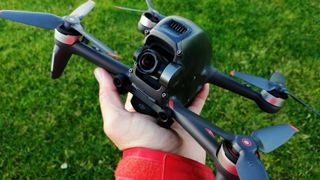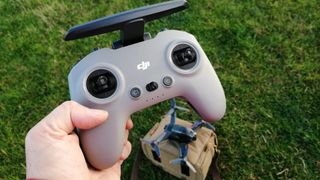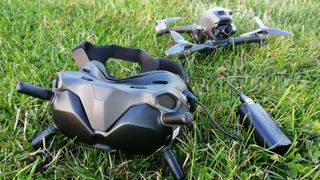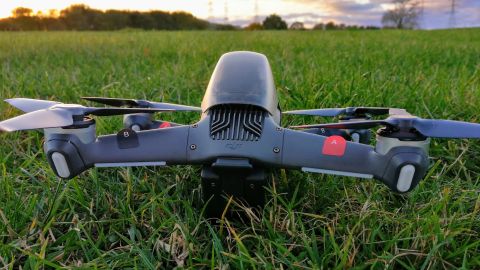Space Verdict
FPV flying is tricky and definitely not to be recommended as a first drone. But for more seasoned flyers, one flight with the DJI FPV will likely have you hooked. Just don’t crash it unless you have rather deep pockets.
Pros
- +
Good build quality
- +
Controller and handheld Motion Controller have great ergonomics
- +
Fast, with amazing aerobatic manoeuvrability
- +
Built in ‘aircraft in proximity’ warnings in headset
Cons
- -
Headset screen dioptre adjustment and pupil distance adjustment could be better
- -
Headset strap quality rather poor
- -
Props visible in video
Why you can trust Space.com
DJI’s entry to the fun-filled world of FPV came in March 2021 in the form of the DJI FPV. Until then, FPV flying — piloting a drone through a first-person-view format, usually by wearing goggles — had been considered something of a specialist niche. The sport is akin to Formula 1 motor racing in drone flying terms, and as such the area had been occupied by a few diehard droneheads with the incredible hand to eye coordination and motor skills required to fly these machines. Before they could even get off the ground, most of these FPV pilots also needed to be possessed of the technical knowledge, skills and capability to build and assemble their aerobatic flying machines from kits of parts.
Weight: Approx 28 oz.
Dimensions: 10x12.3x5 inches
Battery: 2000 mAh Lipo 6s/ Approx. 110 minutes
Charger: 100-240 V, 50/60 Hz, 1.8 A
Modes: Normal, Sport, Manual
Video transmission: Up to 6 miles
Video resolution: 4K
Frame rates: 4K/60fps video at up to 120Mbps
But no longer; the DJI FPV puts this specialist drone category within the grasp of the Captain Slows of the drone world, with a beautifully constructed flying machine that has been designed to make FPV flying accessible, intuitive and fun. It’s definitely one of the best drones that we’ve tested — even if its camera might not impress those who want to focus on aerial photography — because of its simple controls and clever design.
Want to know more about the world of FPV drones? Read through our articles: ‘What are FPV drones?’ and 'Drone racing: Everything you need to know.' Or if you want to get an inside look at the popular DJI model, read on to find out what we made of it.
DJI FPV review: Design
- Fixed (non-foldable) frame
- ‘Chunky’ 795g/ 28oz weight
- Ergonomic & sophisticated controller, hand controller and headset

The DJI FPV doesn’t look much like any other drone on the market. There’s a hint of praying mantis meets HR Giger’s Alien about the sleek plastic aesthetic, and the folding design which is the main feature of DJI’s Mavic range has been dispensed with. Here the motor arms are fixed, and the upright body makes it seem like a larger aircraft than say the Mavic 2 even though it’s lighter.
The larger fixed dimensions means you’ll need a pretty large bag to transport the drone — one big enough to fit its 10x12.3x5 inches dimensions. You will want to remove the propellers when you pack it too as they can easily be deformed in transit. Add to this the goggles, controllers and batteries and you're carrying a fair amount of gadgetry.
In the hand everything feels solid, and once you insert the rather hefty ‘intelligent’ battery, you have a pretty chunky 28oz takeoff weight.
Before you launch though you’re going to need to hook up and establish connectivity between the drone, the DJI FPV goggles and the controller or hand controller. The goggles have their own separate battery and a longish cable — the idea being you can just slip these extra pieces into your pocket while flying. The rest of the process is more or less ‘plug and play’ and once all indicators are green you can don googles and you're ready for take-off.
For the first flight, we used the ‘main’ controller which is not dissimilar in design to other DJI controllers, apart from not having a phone cradle. You won’t miss this, though, as you’re flying through the goggles with a first person view. The control sticks screw into the controls and can be conveniently stored in the controller handles when not in use. The large buttons make it easy to control by feel rather than sight when you’re flying. It's just a case of becoming familiar with the six buttons and their positions.
The DJI FPV also flies with a hand or motion controller. This is a really nice piece of ergonomic design and unlike any controller we have used before, with its throttle grip and brake button.
DJI FPV review: Functionality
- Stills and video functionality limited
- Shoots good quality 4K and 1080p footage
- No raw photos or automated shooting modes

The DJI FPV is a drone made for fun filled flying rather than serious aerial video and photography, and so its moving image and stills capability is somewhat lesser than others in the DJI stable. That said the video quality is still 4K at 50/60fps and 1080p at 50/60/100/120fps; impressive for an FPV drone.
The DJI FPV features a 12MP 1/2.3-inch CMOS sensor with a fixed focal length camera lens equivalent to 14.66mm with a 150-degree field of view and a fixed f/2.8 aperture. The fixed focal length range is 0.6m to infinity, meaning that theoretically everything in shot is in focus, and to be fair this appears to be the case.
The camera is capable of shooting immersive video and video footage can be captured in the Standard and D-Cinelike color profiles at a bit rate of up to 120Mbps. So on the face of it there should be plenty of dynamic range to work with in your video editor of choice.
Overall, the 4K and 1080p video looks fairly good, and aside from the camera capturing the front propellers footage is plenty good enough for posting on YouTube. There is an option for lens distortion which, if switched on, removes the barrel/fisheye distortion the lens otherwise creates. One big difference worth noting is that since this is an FPV drone, the gimbal operates only on the tilt (vertical) axis. But image stabilization (borrowing the DJI tech of the Osmo) takes care of any issues here and again the tech delivers buttery smooth video footage.
The FPV’s photography capabilities are less impressive though, and although it’s easy to switch between video and still shooting with just a long press on the controller shutter button, the quality is such that the DJI FPV is not a drone that you would choose for high quality aerial images. There are only 2 modes, 'Auto' or 'Manual', and both capture JPEGs. Shooting in raw is not an option, and there are none of the automated shooting modes for either stills or video familiar to Mavic users.
Another issue occurs when shooting stills while hovering in any kind of a side breeze. In this scenario the drone will tend to naturally tilt in order to hold position, and since there’s no gimbal movement on the horizontal axis, the result is images that are slightly on the skew. This can be corrected in post in Photoshop (or Premiere for video) but all this adds up to a drone that is best suited and ultimately designed to deliver optimum results when shooting FPV forward-facing video.





DJI FPV review: Performance
- Three flying modes make it suitable for novice FPV flyers
- Fast 87mph in Manual mode
- Obstacle avoidance sensors slow rather than stop

We found that flying the FPV drone was somewhat easier than anticipated. Anyone already familiar with the Mavic series from DJI will be fairly at home with this model, too.
The company has used its expertise from the Mavic series to produce a drone that has flight modes suited to both beginners and more experienced pilots. That said, beginner here is a relative term. If you’ve never flown a drone before, we would highly recommend that you begin on a standard drone model first to get used to the controls and basic flight manoeuvres. The USP of the DJI FPV is the FPV element and its relative ease of use compared to self-built FPV drones.
'Normal' mode uses GPS positioning and the FPV's front and bottom visual positioning sensors. We took off in this mode for our first few flights, and were relieved to find that aside from the unusual and somewhat vertigo-inducing sensation of flying and viewing the world from the drone’s viewpoint, the handling was smooth and — with a top speed of 33mph — easily controllable.
‘Manual’ mode turns the GPS and collision detection off. In this mode experienced FPV pilots can perform aerial stunts and fly around obstacles and tight spaces at speed. When put in manual, the DJI FPV is capable of up to 87mph (0-62mph in two seconds). The incredible burst of speed and acceleration combined with the drone’s tight turning ability is incredibly exhilarating.
‘Sport’ mode is a hybrid of the 'Normal' and 'Manual' modes, offering some of the manoeuvrability of the latter with some of the safety features of the former. You can can still reach speeds of up to 60mph in this mode, so it’s certainly not sluggish.
There is a key difference between the DJI FPV and other DJI models worth noting here; on the Mavic series, the drone automatically stops when the sensors detect an obstacle. Collision detection on The DJI FPV will simply slow the drone down and alert you to the presence of danger, leaving the job of stopping or manoeuvring out of harm’s way to the pilot. This means that even in 'Normal' mode, you still need to take a great amount of care when flying the DJI FPV.
Whatever mode you select to fly in, the big difference you experience in FPV flying is the immersive drone point of view. It really is the closest thing to flying you can get without your feet leaving the ground. The screen view is crisp and sharp, although we struggled a bit to adjust it to our eyesight using the dioptre sliders. Also, the screen is so large that some of the flight information is on the edge of your peripheral vision, which makes reading it tricky.
Changing the camera and flight settings in the goggles takes a little getting used to, as it’s not as easy as using a phone cradled on a controller. We fumbled around with the buttons on top of the headset for quite a while, and would have much preferred a system which used a blink or eye movement to accept a command. Given this is probably still beyond even DJI engineers, accessing the headset commands from either the controller or motion controller would be more intuitive.
On the subject of the motion controller, this is a really nice and new way of controlling the drone which we thoroughly enjoyed. The ergonomic design and placement of the buttons, throttle and user interface controls made flying easier and more intuitive. It really is point and shoot! Just point the controller where you want the drone to go and pull the trigger. A twist of the wrist and it turns. Worth noting though that it only works in Normal and Sports modes not Manual.
Should you buy the DJI FPV?
This particular model is probably best suited to those who have some previous drone flying experience, and also have a bank balance which can afford the rather hefty outlay and inevitable repair bills. The DJI FPV offers a great way of getting into FPV and the flying experience is really like no other. But FPV flyers make their own cheap and lightweight kits for a reason.
Well-constructed from ‘advanced’ plastics it may be. But there is no way this drone is coming away from any kind of high-speed collision unscathed and in one piece. So with this price tag, and even with DJI Care refresh/ Insurance, it’s a risky and potentially expensive proposition.
Also while the video specs are great, still imagery is not, and so again that’s probably enough to put off those who want to take high quality aerial shots. This is a machine for physics defying moves and flying …fast! If that's what you're looking for, then this is the drone for you.
If this product isn't for you
For beginners the DJI FPV is a no no. You’re much better off learning and becoming adept on something like the Mavic 2 Pro or even the DJI Mini 2.
Join our Space Forums to keep talking space on the latest missions, night sky and more! And if you have a news tip, correction or comment, let us know at: community@space.com.
Myles Cummings has been flying drones since 2017. Originally a trained architect he now enjoys aerial photography of architecture as much as designing it. He is looking forward to the time when international travel is straightforward again. Still on his bucket list of must drone spots is The Millau Viaduct Bridge and the Louvre Abu Dhabi.

